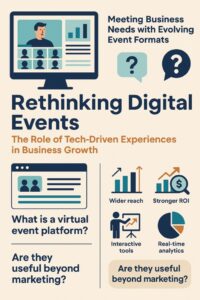Business
Rethinking Digital Events: The Role of Tech-Driven Experiences in Business Growth
Meeting Business Needs with Evolving Event Formats
In a world where flexibility and digital-first thinking are now expected, the way organisations run events has changed permanently. Physical conferences and exhibitions were once the cornerstone of business networking and knowledge sharing. Today, those same goals are often being achieved through virtual or hybrid experiences, driven by technology and designed for scale.
Business leaders and marketing professionals are increasingly asking:
- How do virtual event experiences compare to in-person engagements?
- What tools are required to run successful digital events?
- Can online events really support long-term growth and sales goals?
This article addresses these key questions while offering a strategic view on how businesses can leverage virtual events not just for convenience, but for measurable results.
The Strategic Shift: Why Businesses Are Moving to Virtual Event Platforms
Organisations are not just choosing digital formats for cost-saving reasons. They’re doing so because they can achieve more, reach wider audiences, collect more meaningful data, and offer a more personalised user journey.
A well-designed virtual event platform enables businesses to replicate the structure and professionalism of a physical event while enhancing it with interactive tools, real-time analytics, and scalable content delivery. These platforms have become the infrastructure supporting the next generation of B2B events.
Whether it’s a product launch, a training seminar, or a global leadership summit, the ability to host, monitor, and optimise the entire experience is now not only possible but expected.
FAQs: What Business Leaders Want to Know
What is a virtual event platform, and how is it different from a video call?
A virtual event platform is a digital environment built specifically to host structured, large-scale events such as conferences, trade shows, and summits. Unlike basic video conferencing tools, these platforms provide features like breakout rooms, registration tracking, live polling, attendee networking, and post-event analytics.
Is it suitable for enterprise-scale requirements?
Yes. Most virtual platforms are designed to handle thousands of participants simultaneously, with integrations for CRM, marketing automation, and content management systems.
What’s the ROI like?
Virtual events typically offer better data and broader reach than traditional events, often resulting in a stronger return on investment, particularly when looking at cost per lead and content longevity.
Are they useful beyond marketing?
Absolutely. From internal team building and training to client onboarding and investor relations, the applications of virtual events extend well beyond marketing departments.
Building Engagement into the Event Experience
Audience attention is a limited resource, especially in digital spaces. The key to a successful virtual event lies in creating moments of interaction, not just presentation.
Here’s how businesses are engineering more engaging digital experiences:
- Personalised Agendas
Allowing attendees to select sessions relevant to their interests encourages ownership and higher engagement rates. - Interactive Elements
Live Q&A sessions, real-time chat, audience polling, and clickable resources help replicate the two-way engagement of physical events. - Dynamic Content Delivery
A mix of live-streamed keynotes, pre-recorded interviews, panel discussions, and downloadable assets caters to different learning and participation styles. - Follow-Up Campaigns
Post-event engagement is critical. Data from attendee behaviour can drive personalised email follow-ups, retargeting campaigns, and more targeted outreach.
When these elements are built into the platform from the start, the result is a more cohesive and compelling experience.
The Business Case: From Awareness to Action
Marketing teams are under increasing pressure to not only generate leads but also to qualify and nurture them. A virtual event is uniquely positioned to do both.
Attendee behaviours—such as how long someone watched a session, what questions they asked, or what resources they downloaded—are invaluable for scoring leads and identifying buying signals. This depth of insight is far harder to obtain in traditional in-person formats.
Virtual events also support broader campaign integration. Event registrations can trigger email nurture sequences. On-demand content can be repurposed for SEO, and highlights can be shared across social media to extend campaign reach.
This makes virtual events not just standalone activities but integral components of modern marketing strategies.
Platform Features That Enable Success
Not all virtual platforms are created equal. Businesses investing in this space should look for features that go beyond just streaming capabilities.
Scalability – Ability to host small, medium or enterprise-scale events without sacrificing performance.
Custom branding – Tools to align the event interface with your brand identity.
Real-time engagement – Chat, polling, downloadable resources, and breakouts to facilitate interaction.
Analytics – Track not just attendance but also engagement depth and conversion.
Integration – Sync with CRM, marketing automation platforms and other core tools.
Security – Encrypted data handling and access management features to protect proprietary information.
The better the platform aligns with your objectives and workflows, the smoother your event will run and the more value you will extract from it.
Common Mistakes and How to Avoid Them
Even with the best intentions, organisations new to virtual events often fall into predictable traps. Here’s what to look out for:
- Underestimating the planning required
Virtual events may seem easier to execute, but they demand the same level of logistical planning as physical ones, sometimes more. - Choosing a platform that lacks flexibility
Your chosen platform must be adaptable to your specific needs. Don’t settle for tools that offer limited engagement or poor analytics. - Neglecting rehearsal and tech testing
Speakers and hosts should rehearse in the environment they’ll be using. Test internet connections, audio quality, and platform compatibility ahead of time. - Overloading the agenda
Keep sessions concise and avoid long, back-to-back programming. Breaks matter even in virtual spaces.
Learning from these common issues will help your team execute more confidently and professionally.
Future Outlook: A Hybrid-Ready World
As offices reopen and travel resumes, many companies are exploring hybrid models combining in-person attendance with digital accessibility. A strong virtual event platform will allow seamless delivery across both formats.
Hybrid models ensure no audience segment is excluded due to geography, travel budget or accessibility needs. More importantly, they give businesses the best of both worlds: the intimacy of face-to-face interactions with the reach and measurability of digital.
The tools and skills developed for virtual-first events will become foundational for future hybrid strategies.
Final Thoughts: The Competitive Edge of Going Virtual
In today’s fast-paced digital economy, events are no longer just calendar entries. They are powerful business drivers who build brand awareness, generate qualified leads, educate audiences, and support strategic relationships.
Choosing the right virtual event platform can be the differentiator between a forgettable webinar and a high-impact brand experience. The technology is there. The audience is ready. The question for businesses is whether they’re prepared to use these tools to their full potential.
Investing in this capability isn’t about following a trend. It’s about building resilience, scale, and smarter ways to connect in a world where expectations and behaviours have permanently shifted.






